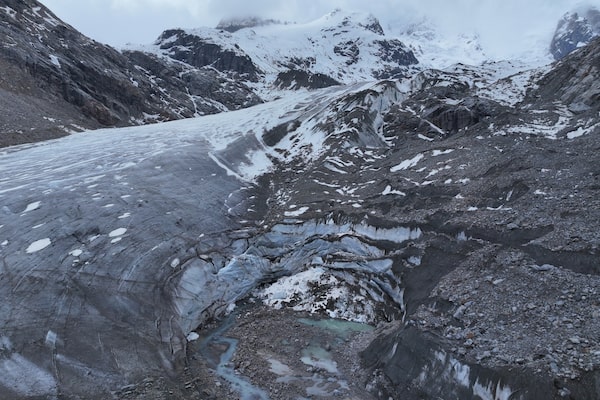
The receding Morteratsch glacier, including a collapsed portion, near Pontresina, Switzerland, on May 21.Sean Gallup/Getty Images
Fears that glaciers in Italy and Switzerland will melt away like ice cream dropped on a hot sidewalk deepened this week when temperatures hit zero degrees Celsius at record altitudes in both countries.
Overnight temperatures on Monday reached zero degrees in the Italian Alps at 5,328 metres, Italian weather site ilmeteo.it reported. At the same time, a weather balloon launched from Payerne, in western Switzerland, registered the zero-degree line in the Swiss Alps at 5,298 metres, beating the record of 5,184 metres set last year.
Temperatures decrease with altitude. The MétéoSuisse weather site explained that the zero-degree isotherm “separates layers of air with temperatures above 0°C at low altitudes from those below freezing at higher altitudes.”
Isotherm levels are watched closely by meteorologists, hydrologists, farmers and global-warming scientists. The higher the zero-degree isotherm, the faster the melting pace of glaciers and snow packs. When glaciers disappear, so does their store of water. The lack of Alpine runoff could trigger a watershed crisis that would affect everything from crop yields and hydro power to wildlife and tourism.
Renato Colucci, a glaciologist at Italy’s National Research Council, has called many of the Alpine glaciers in Italy, Switzerland and Austria “the walking dead,” since they are eroding quickly as average temperatures rise. In a tweet, he called the record zero-degree levels recorded this week “another blow for glaciers that have already strongly suffered this year. Snow coverage is only present at the highest elevations.”
The summer heat wave, which has broken records in parts of Europe, has been so intense that not one of Italy’s 773 glaciers was above the zero-degree line this week. All of Switzerland’s snow-capped Alpine peaks had air temperatures above zero degrees on Monday. The highest among them was the summit of Monte Rosa, on the Swiss-Italian border, at 4,634 metres.
Ice has been vanishing in Italy for decades. Until the 1990s, small glaciers could be found as far south as Gran Sasso (2,912 metres), in the Apennine mountain range east of Rome – about 700 kilometres south of the Alps. They are all gone. Glaciologists think glaciers on Alpine mountains of less than 4,000 metres are unlikely to survive over the long term.
On the Italian side of Western Europe’s highest peak, Mont Blanc, only a few dozen kilometres from Monte Rosa, scientists are preparing for the collapse of the Planpincieux Glacier. The lower part of the medium-sized expanse of Alpine ice has been sliding down the mountain at the rate of about 50 centimetres a day. The road beneath the glacier has been ordered closed by the mayor of Courmayeur, a nearby Italian resort town, as the threat of a massive collapse increases.
The melting glaciers and snow packs are not just bad news for agriculture; they are devastating for ski resorts. Italian environmental group Legambiente last year said that 249 Italian ski resorts had closed in recent years because of lack of snow. The vast majority of those that have survived the rising temperatures use snow cannons to keep some runs open. It appears that only the highest-altitude resorts will stay open as global average temperatures rise.
The news of the record zero-degree levels came as some parts of Southern Europe entered the summer’s third heat wave. In Rome on Tuesday the temperature reached 38 C, hotter than Cairo or Tunis in North Africa. The latest European heat wave has been called Nero, after the Roman emperor who, according to legend, played his fiddle while Rome burned.
 Eric Reguly
Eric Reguly